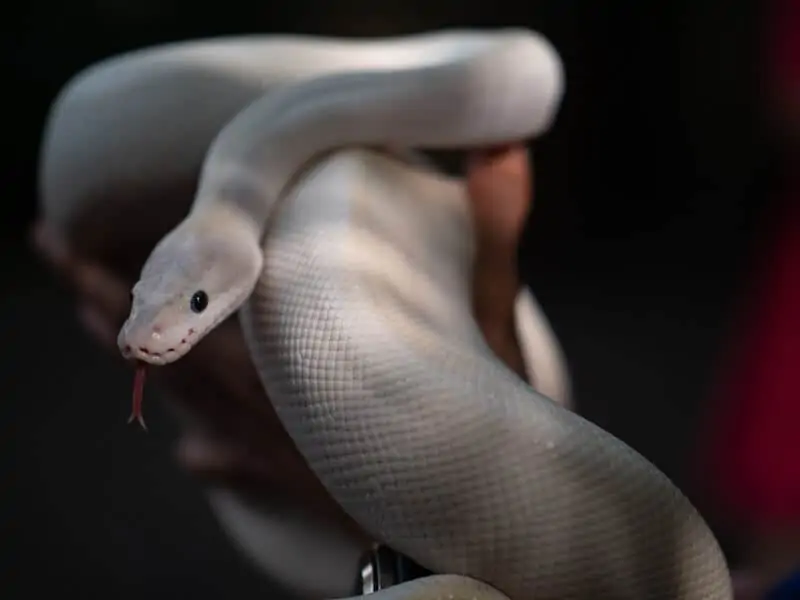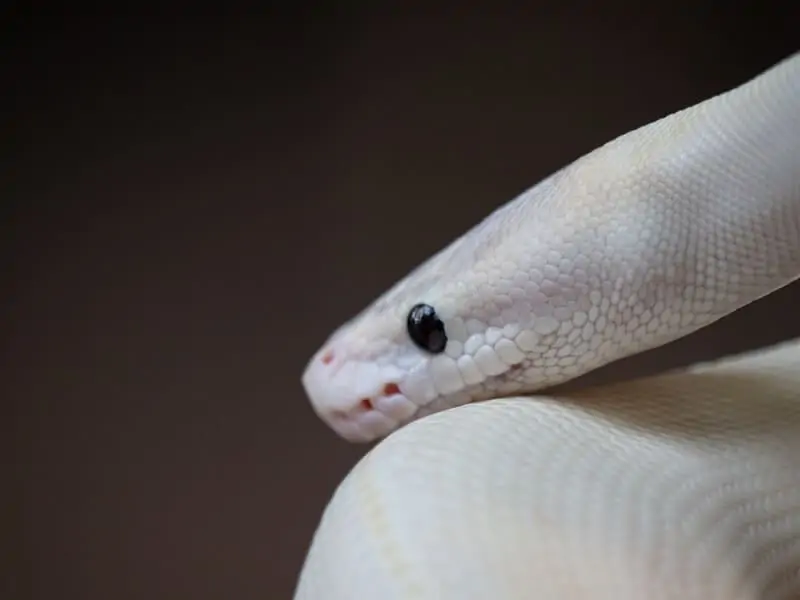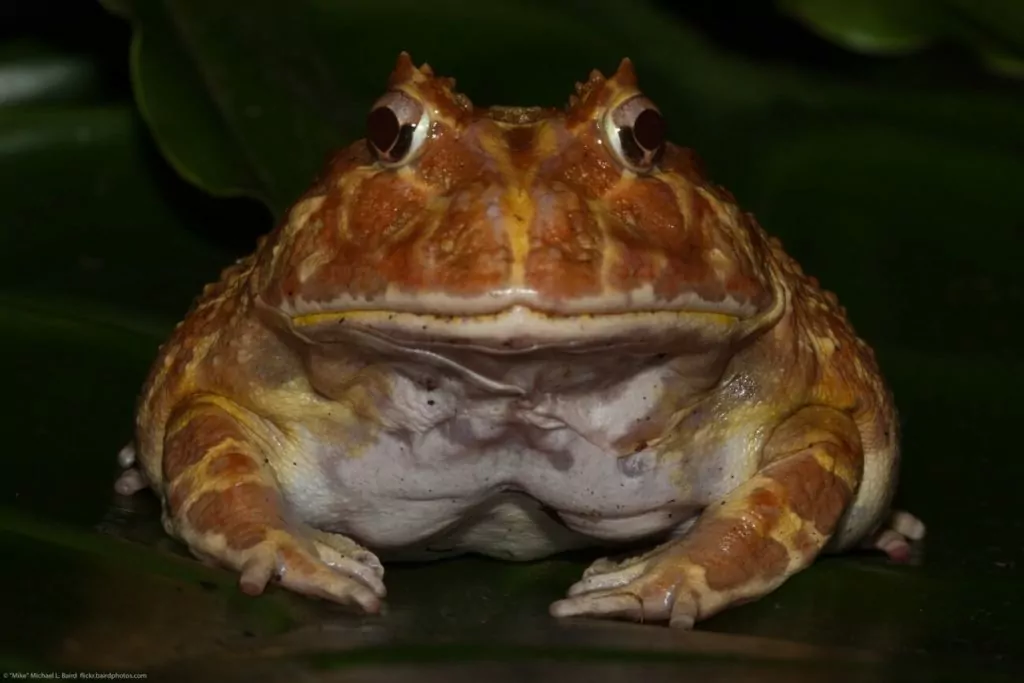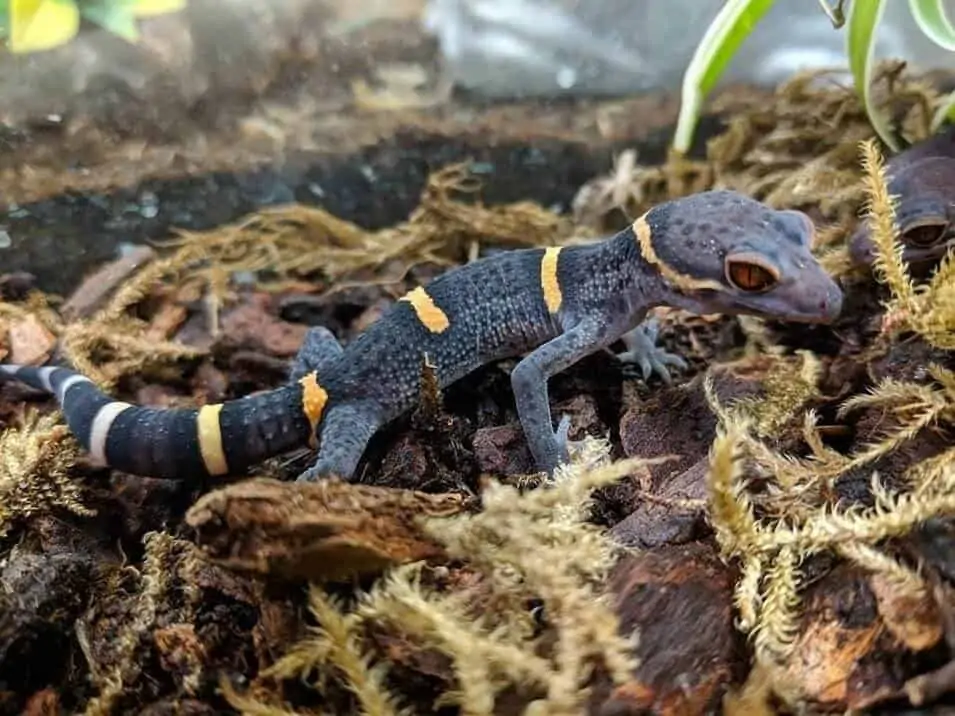Blue eyed leucistic ball pythons are gorgeous snakes that can also make great pets. But their rarity means it’s hard to get your hands on one (and expensive).
If you’re interested in owning one for yourself, there are a few things you should know first. This guide will provide all the information you need on blue eyed leucistic ball python care.
Table of Contents
Species Summary
The blue eyed leucistic ball python is a treat for the eyes! Referred to by many in the hobby as BEL pythons, this snake isn’t a distinct species. Instead, it’s a rare morph of the standard ball python (Python regius).
It doesn’t take an expert to realize why these snakes are so sought-after! They have a breathtaking appearance that looks wildly different from most other variants.
Since its introduction in the 1980s, ball pythons have been a favorite among breeders. Selective breeding techniques resulted in thousands of eye-catching ball python morphs. The blue eyed leucistic ball python is one product of this process, and many would argue that it’s one of the most beautiful.
These snakes are rare, but if you’re lucky enough to get your hands on one, they can be a joy to raise, no matter your skill level.
What Makes Them So Rare?
There’s a reason why you don’t see too many blue eyed leucistic ball pythons as pet snakes. They’re incredibly difficult to breed!
Leucism is a condition that results in the partial loss of pigmentation in the skin. Usually, Leucistic snakes have patches of white while still maintaining their normal coloration elsewhere. That’s what makes leucism different from albinism.

Blue eyed leucistic ball pythons are an even greater rarity. Its entire body is white. The only exception that prevents it from being an albino ball python is the signature eyes.
That brings us back to the breeding process. To create a genuine blue eyed leucistic ball python, breeders have to pull the genes of two different morphs. But it’s not just one generation.
These beautiful snakes require the genes of two morphs over three generations!
What morphs do breeders use? Typically, they create pairings out of five different morphs. These include:
- Mojave ball pythons
- Lesser ball pythons
- Butter ball pythons
- Het russo ball pythons
- Phantom ball pythons
Expert Tip: None of those morphs exist in nature, either. It took a lot of cross-breeding to birth the first blue eyed leucistic ball python, and the struggle to breed more is just as prevalent today!
The next time you see one of these beauties and its accompanying high price tag, you can appreciate all that goes into breeding one!
Appearance & Colors
Blue eyed leucistic ball pythons are easy to identify. Their defining features are the white skin and icy blue eyes.
You may come across snakes that have cream-colored skin or small patches of color. Some even have a beige-yellow band running down the spine. Those are still blue eyed leucistic ball pythons, but they’re generally less desired than the pure white specimen.
Those with some pigmentation left in their skin might be one of the younger generations as the breeder tries to create the perfect baby BEL. Beyond the physical “imperfections,” they’re still great snakes to raise. Plus, they’re much more affordable in most cases.
The second signature detail is the eyes! As their name would suggest, these snakes have bright blue eyes. The iris features vibrant coloration, while the pupil is black like any other snake.
Expert Tip: For owners and breeders, the blue eyes are the most critical feature of this morph. It’s what separates the leucistic snake from its albino cousins.
Beyond the distinct coloration, blue eyed leucistic ball pythons look like every other snake of the same species. They’re girthy constrictors with triangular heads and broad snouts.
Because of their white coloration, the heat-seeking nostrils on their snouts are more pronounced than other morphs. Don’t worry, that small line of pits is totally normal!
Blue Eyed Leucistic Ball Python Size
The average blue eyed leucistic ball python size is between three and five feet for full grown adults. There’s a lot of variation here, and you’ll notice a big difference between males and females.
Females have a slower growth cycle and are usually on the upper end of the size spectrum, growing bigger than males. On rare occasions, female snakes can even max out at six feet!
Expert Tip: When they first hatch, most young snakes emerge from their shells measuring a mere 10 inches long or so. They grow at a moderate pace, reaching three feet by the two or three-year mark. Males usually get their full adult size by three years old, with females not long after that.
In terms of width, blue eyed leucistic ball pythons are pretty stocky. They have thick and muscular bodies which they use for squeezing their prey. Unfortunately, these snakes are prone to weight gain, so maintaining a strict diet is a must. More on that later.
Lifespan
With proper care, the lifespan of a blue eyed leucistic ball python is usually between 20 and 30 years. That said, they’re certainly capable of living more. There are reports of captive-raised snakes living closer to 50 years.
However, those instances usually involve standard ball pythons. Thanks to their rarity, detailed life expectancy information surrounding this specific morph is a little harder to come by.
As always, there’s no way to know for sure how long these reptiles will live. Too many factors come into play. Generally, providing top-notch blue eyed leucistic ball python care will increase the chances of your snake living to the upper end of the lifespan spectrum.
Blue Eyed Leucistic Ball Python Care
Believe it or not, blue eyed leucistic ball python care is pretty beginner-friendly. They don’t have any special care requirements compared to other color morphs. As a whole, these snakes are undemanding and easy to please.
As long as you cover the basics and provide the essentials, these snakes have no problem living long and happy lives. Check out the established care guidelines below for some direction.
Enclosure Size
These snakes don’t need a massive enclosure to stay happy. Despite their large size, blue eyed leucistic ball pythons have relatively manageable enclosure requirements.
Hatchings can live in a 10-gallon aquarium. When they reach juvenile status, which is between six months and three years old, they can do well in a 20-gallon aquarium.
Adults will need to live in an enclosure with 40 gallons of volume. The standard dimensions for a 40-gallon tank are around 36 inches long, 18 inches wide, and 16 inches tall.
You have several options when it comes to enclosure material and style. Generally, glass aquariums and reptile terrariums are acceptable. Make sure that the habitat has a tight-fitting lid for protection.
If you want to make things as easy as possible, consider using a plastic enclosure. Many collectors use opaque plastic tubs. These snakes tend to fare well in plastic enclosures because they offer more privacy and easier humidity control.
Expert Tip: The privacy the snake gets is excellent for its lifestyle. Of course, many snake-owners want to see their prized reptile. With a gorgeous morph like the BEL Python, it’s perfectly reasonable to want to use glass.
Just remember that you’ll have to work harder to create privacy for your snake.
What To Put In Their Habitat
Now, let’s move on to enclosure decorations and must-haves. The goal here is to make the space as comfortable as possible. If you’re using a plastic enclosure, you’ll only need to add a few essential items.
Hide boxes are one of the most important additions. Add two hide boxes on opposing ends of the enclosure for privacy. Your snake will curl up in the box during the day.
Beyond that, you can add general cover items like branches, moss, fake plants, and logs. If you’re using a glass or PVC enclosure, try to add plenty of clutter so that your snake feels comfortable enough to slither out of the hide box. Those items serve as protection and security while also adding privacy.
So, what about the substrate?
These snakes do well living on most substrate materials. Those wanting to keep things simple and mess-free can use newspapers or a reptile carpet. However, the best choice is a natural, absorbent particulate.
Cypress mulch and organic topsoil are good choices. Whatever you use, make sure it’s free of additives and chemicals. For topsoil, go for formulas that are perlite-free for safety.
Temperature & Lighting
Like all reptiles, blue eyed leucistic ball python care requires you to provide a perfectly maintained environment with the proper temperatures. As cold-blooded creatures, these snakes move around their environment to thermoregulate. You’ll need to create a suitable temperature gradient to facilitate that behavior.
There should be a cool side, a warm side, and a basking area.
- On the cooler end, ambient temperatures can be around 76 to 80 degrees Fahrenheit.
- For the warmer side of the enclosure, aim 82 or 83 degrees Fahrenheit.
- You’ll need to set up a lamp for the basking area. Use it to raise the temperature there to between 88 and 92 degrees.
Expert Tip: Don’t let the enclosure get colder than 75 degrees. If you experience frigid nights, install a ceramic heat emitter or under-tank heater to keep things stable.
Set all of your lights on timers and keep a steady cycle. Blue eyed leucistic ball pythons have a specific circadian rhythm to maintain. Simulate the day and night cycle to keep your snake healthy.
Avoid putting your tank near a window. Many new snake owners make that mistake as they attempt to provide some natural sunlight. It’s better to have precise measurements than rely on the uncertain nature of outdoor lighting to heat your snake’s enclosure.
Humidity
One of the most important aspects of blue eyed leucistic ball python care is humidity. Humidity levels should be between 50 and 60 percent.
Invest in a hygrometer, as the humidity levels are one of the most important environmental parameters to maintain. When things are off, your snake will suffer.
Expert Tip: Fortunately, there are many things you can do to raise the humidity. Your substrate material will hold onto water to keep things stable. Occasional misting with water can do the rest when needed.
Water
Don’t be surprised if you never see your blue eyed leucistic ball python drink get water by lapping it up. Most pythons will absorb moisture in the air or through soaking to stay hydrated.
Either way, providing access to clean water is a must. Install a large container of water in the enclosure. It should be big enough for the snake to slither in for a soaking.
Spot clean messes if they defecate in there. Don’t forget to replenish the water regularly and give the container a good cleaning every couple of days to prevent mold growth.
Food & Diet
Feeding a blue eyed leucistic ball python is pretty straightforward.
The snake’s wild counterparts feed on small rodents and birds. They’re natural-born hunters that will constrict their prey before swallowing them whole! A meal can provide enough energy for several days, making feedings few and far between.
In captivity, the best food to provide is feeder mice and rats. Some herpetology enthusiasts like to provide live rodents. While the takedown and subsequent constriction are fascinating to watch, live feed presents a safety hazard.
Rodents can end up scratching or biting your snake, leading to the risk of bacterial infections.
To avoid all that, stick to frozen mice. Let the rodent thaw to room temperature before feeding so that your snake can recognize it as food.
It’s also important to space out their feedings based on age. Here are the timelines to get familiar with:
- Young hatchlings will need pinkies or small fuzzy mice every five to seven days.
- As they reach six months old, you can feed larger rodents every seven to ten days. Your snake will grow a lot during the juvenile phase, so make sure that rodents are no bigger than the broadest part of the body to keep them safe.
- After your snake reaches their full adult size, provide medium-sized rats every ten days or so. You may need to increase frequency during times of shedding.
Potential Health Issues
Many designer color morphs are genetically prone to extra health issues. Luckily, that’s not the case with blue eyed leucistic ball pythons. They’re pretty healthy and have no increased risk of complications.
That said, they can still suffer from all the usual ailments.
Like all ball pythons, these snakes are subject to mites, internal parasites, respiratory infections, and mouth rot.
Many of those conditions are avoidable with proper enclosure maintenance. Stay on top of humidity and temperature settings to keep the environment stable. Don’t forget to clean regularly, too.
Spot clean when necessary and do a top-to-bottom sanitization about once a month. That should keep bacteria and parasites at bay.
These snakes are also at risk of inclusion body disease. It’s a viral infection with no cure. Euthanasia is typically the only outcome.
The disease is contagious and spreads through contact. To keep your snake safe, wash your hands regularly. Practice safe handling methods and avoid handling snakes in quick succession if you’re unsure about their health.
Behavior & Temperament
Blue eyed leucistic ball pythons are a relaxed species. They live sedentary lifestyles and are only active when they hunt.
During the day, your snake will likely relax in its hide box. They prefer to stay away from the sun and light, choosing to sleep in private as the sun glares overhead. Once the lights go down, they become more active as they look for food.
In colder climates, these snakes sometimes go into a quasi-hibernation mode. They slow down their metabolism and eat less frequently to save energy.
Feeding strikes shouldn’t occur in captivity. Typically, it only happens when there’s a change in temperature and humidity levels. Pay extra attention to the enclosure parameters around seasonal changes to ensure stability across the board.
You should never keep two blue eyed leucistic ball pythons together. These snakes like to avoid each other in the wild and only interact when they breed. Having another snake in the mix will only cause undue stress for your BEL Python.
Handling
Ball Pythons are relatively friendly and accept handling well.
That said, you have to build trust before handling can become a regular thing. At first, your snake will likely be a bit suspicious of you. They might spend more time in hiding to avoid you.
Shy behavior is normal. Your snake needs time to adjust to its new surroundings and establish some trust with you. Give it some time before you attempt to make physical contact.
When you and your snake are ready, start by gently rubbing its back in the enclosure. As you use your hand to make contact, keep an eye on its physical reaction. Should it tenses up or jerks around, back off a bit.
Bites are rare with ball pythons, but they can occur.
Repeat this process until your snake is ready for handling. Pick it up by the broadest part of its body and support the rest of its weight as you lift it from the enclosure.
Let your blue eyed leucistic ball python get comfortable and find a relaxed position. It may wrap itself around your hand or arm. As long as it doesn’t constrict, let it do its thing.
After handling, make sure to wash your hands thoroughly to avoid spreading bacteria and pathogens.
Conclusion
Blue eyed leucistic ball python care isn’t much different than other ball python morphs. Overall, they’re quite manageable for owners of all experience levels.
We hope you found this guide helpful. If you have questions about any information that we didn’t include above, feel free to ask us!



